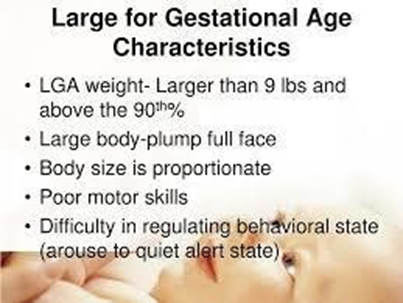The nurse prepares to assess a newborn who is considered to be large-for-gestational-age (LGA). Which characteristic would the nurse correlate with this gestational age variation?
birthweight of 7 lb, 14 oz (3,572 g)
strong, brisk motor skills
difficulty in arousing to a quiet alert state
wasted appearance of extremities
The Correct Answer is C
A. A birthweight above the 90th percentile for gestational age is characteristic of large-for-gestational-age newborns. The above birth weight is within the normal ranges.
B. Strong, brisk motor skills are not necessarily indicative of being large-for- gestational-age.
C. Large-for-gestational-age newborns. They may have difficulty in arousing to a quiet alert state due to hypoglycemia, hypocalcemia, or polycythemia.
D. A wasted appearance of extremities is more indicative of intrauterine growth restriction (IUGR) rather than being large-for-gestational-age. LGA newborns typically have plump and rosy appearance.

Nursing Test Bank
Naxlex Comprehensive Predictor Exams
Related Questions
Correct Answer is C
Explanation
A. Surgery may be considered in severe cases or if conservative treatments fail, but it is not typically the first-line treatment for Erb's palsy.
B. Immobilization may be part of the treatment plan in some cases, but it is usually accompanied by physical therapy rather than being the sole treatment.
C. Physical therapy is often the initial treatment for Erb's palsy, focusing on gentle stretching exercises, range of motion activities, and strengthening exercises to improve muscle function and joint mobility.
D. While Erb's palsy may improve over time for some infants, early intervention with physical therapy is generally recommended to optimize outcomes and prevent long- term complications.
Correct Answer is C
Explanation
A. A birthweight above the 90th percentile for gestational age is characteristic of large-for-gestational-age newborns. The above birth weight is within the normal ranges.
B. Strong, brisk motor skills are not necessarily indicative of being large-for- gestational-age.
C. Large-for-gestational-age newborns. They may have difficulty in arousing to a quiet alert state due to hypoglycemia, hypocalcemia, or polycythemia.
D. A wasted appearance of extremities is more indicative of intrauterine growth restriction (IUGR) rather than being large-for-gestational-age. LGA newborns typically have plump and rosy appearance.

Whether you are a student looking to ace your exams or a practicing nurse seeking to enhance your expertise , our nursing education contents will empower you with the confidence and competence to make a difference in the lives of patients and become a respected leader in the healthcare field.
Visit Naxlex, invest in your future and unlock endless possibilities with our unparalleled nursing education contents today
Report Wrong Answer on the Current Question
Do you disagree with the answer? If yes, what is your expected answer? Explain.
Kindly be descriptive with the issue you are facing.
